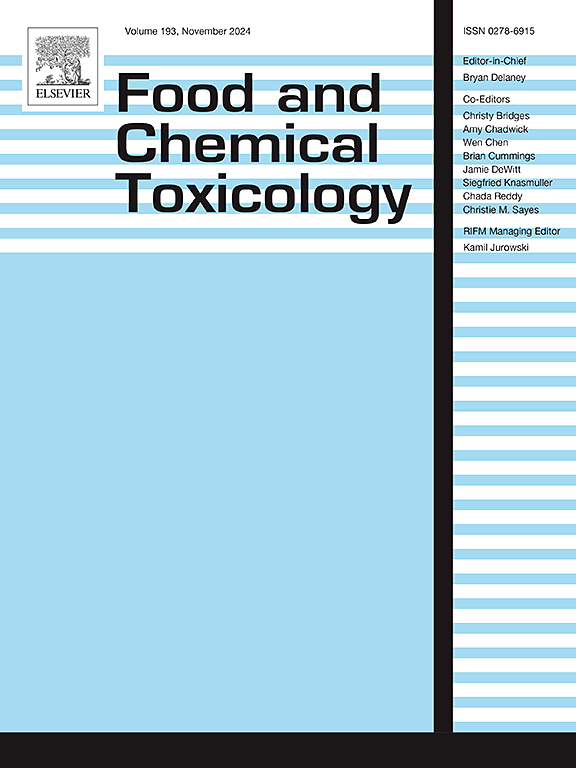CDDO-Me triggers ROS-dependent ferroptosis and apoptosis in cervical cancer via targeting PI3K/Nrf2 pathway
IF 3.5
3区 医学
Q2 FOOD SCIENCE & TECHNOLOGY
引用次数: 0
Abstract
Context
Cervical cancer (CC) ranks as one of the most common types of malignant tumors affecting women. CDDO-Me is derived from oleanolic acid, a pentacyclic triterpenoid obtained by chemical structural modification, which has been shown anti-tumor effects.
Results
CC cell proliferation was decreased by CDDO-Me both in vitro and in vivo. Mechanistically, CDDO-Me led to a reduction of intracellular mitochondrial volume and crista, or an increase of membrane density. The levels of ROS, Fe2+, MDA were increased while GSH was decreased. Meanwhile, the levels of protein expression of GPX4, Nrf2, NQO1 and FTH1 were observably inhibited by CDDO-Me. Specifically, ferroptosis triggered by CDDO-Me was reverted by DFO. It has been demonstrated that CDDO-Me-induced apoptosis and ferroptosis in CC cells is contingent upon the PI3K/AKT-mediated Nrf2/NQO1 pathway.
Conclusions
CDDO-Me induces CC cell lines apoptosis and ferroptosis through the PI3K/Nrf2 signaling pathway, for exerting anti-proliferation effects.
CDDO-Me通过靶向PI3K/Nrf2通路触发ros依赖性宫颈癌铁下垂和凋亡
宫颈癌(CC)是影响妇女的最常见的恶性肿瘤之一。CDDO-Me由齐墩果酸衍生而来,齐墩果酸是一种五环三萜,经化学结构修饰得到,具有抗肿瘤作用。结果CDDO-Me对体外和体内scc细胞增殖均有抑制作用。机制上,CDDO-Me导致细胞内线粒体体积和嵴减少,或膜密度增加。ROS、Fe2+、MDA水平升高,GSH水平降低。同时,CDDO-Me显著抑制GPX4、Nrf2、NQO1和FTH1蛋白的表达水平。具体来说,CDDO-Me引发的铁下垂可通过DFO恢复。研究表明,cddo -me诱导的CC细胞凋亡和铁凋亡取决于PI3K/ akt介导的Nrf2/NQO1通路。结论scddo - me通过PI3K/Nrf2信号通路诱导CC细胞株凋亡和铁凋亡,发挥抗增殖作用。
本文章由计算机程序翻译,如有差异,请以英文原文为准。
求助全文
约1分钟内获得全文
求助全文
来源期刊

Food and Chemical Toxicology
工程技术-毒理学
CiteScore
10.90
自引率
4.70%
发文量
651
审稿时长
31 days
期刊介绍:
Food and Chemical Toxicology (FCT), an internationally renowned journal, that publishes original research articles and reviews on toxic effects, in animals and humans, of natural or synthetic chemicals occurring in the human environment with particular emphasis on food, drugs, and chemicals, including agricultural and industrial safety, and consumer product safety. Areas such as safety evaluation of novel foods and ingredients, biotechnologically-derived products, and nanomaterials are included in the scope of the journal. FCT also encourages submission of papers on inter-relationships between nutrition and toxicology and on in vitro techniques, particularly those fostering the 3 Rs.
The principal aim of the journal is to publish high impact, scholarly work and to serve as a multidisciplinary forum for research in toxicology. Papers submitted will be judged on the basis of scientific originality and contribution to the field, quality and subject matter. Studies should address at least one of the following:
-Adverse physiological/biochemical, or pathological changes induced by specific defined substances
-New techniques for assessing potential toxicity, including molecular biology
-Mechanisms underlying toxic phenomena
-Toxicological examinations of specific chemicals or consumer products, both those showing adverse effects and those demonstrating safety, that meet current standards of scientific acceptability.
Authors must clearly and briefly identify what novel toxic effect (s) or toxic mechanism (s) of the chemical are being reported and what their significance is in the abstract. Furthermore, sufficient doses should be included in order to provide information on NOAEL/LOAEL values.
 求助内容:
求助内容: 应助结果提醒方式:
应助结果提醒方式:


